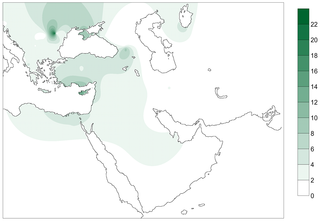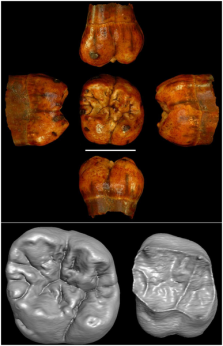Humans have a long history of migration and expansion. From humble origins in Africa our family has spread throughout the world. Recently new research has been published that sheds light on two of the most important expansions of the human family. The first deals with how wheat-wielding farmers conquered Europe ~10,000 BC1; the other suggests that early, ape-like hominins might have had a territory much larger than previously believed more than 2 million years ago2.
#1: Wheat warriors conquered Europe via Cyprus and Crete
Farming was first invented in the Middle East, around 10,000 BC. From there it spread throughout the rest of Europe over the next few millennia1. Interestingly, genetic studies show that this spread wasn’t a case of the indigenous Europeans copying the new technology; but of these farmers driving out the former inhabitants and taking over their land3. Now more genetic research has shed light on the route these wheat-wielding conquers took as they conquered the continent: they came by sea.
Researchers examined mtDNA from skeletons dating to this period, allowing them to identify genetic markers associated with these early farmers; allowing them to track their spread throughout Europe by looking for their modern descendants.

The percentage of modern people in Europe with markers from the early farmers
Their results revealed that these markers were very common along the coast and exceptionally frequent on islands (Cyprus and Crete in particular seem to have been hubs for these farmers), strongly suggesting they took an ocean route into Europe. This also aligns with the archaeological evidence, with these islands having the oldest record of farming culture outside of the Near East and the coasts having the next oldest1.
There’s another interesting upshot of this study: most of the markers of farmers are no longer present in modern populations. In fact, all but one of the markers have disappeared (or almost disappeared) from humanity, meaning that most of the lineages of farmers has died out. As successful as they were at conquering Europe, it seems that still only a fraction of the farming families survived to the present1.
#2: Earliest hominins had a larger territory than previously believed
Before we were a worldwide species, we were an African one. And before we we conquered that continent our most distant ancestors only inhabited a tiny sliver of East & South Africa. In fact, with one exception, all human from prior to 2 million years ago come from only four countries! However, re-examination of a fossil tooth from Central Africa suggests our ancestors might have had a larger habitat than previously known.

360 no-scope tooth headshot
The tooth itself has quite an interesting story. It was originally uncovered in the Democratic Republic of Congo at a recent, modern human, archaeological site in the 1950s. However, the tooth just doesn’t look like a modern human, so was filled away as odd for half a century. Recently it was dug up again (metaphorically this time) and re-examined with spectroscopy. This revealed that it wasn’t originally from the strata it was found in, and actually came from a much older rock layer; dated to 2 – 2.6 million years old based on fossils found in the layers above and below it2.
This prompted a fancy computer analysis of the tooth itself, which showed it to be very similar to an Australopithecine tooth. Australopithecus were early ape-like (albeit upright walking apes) members of the human family that lived around the same time as the rock layer the tooth was found in2.
I do have one qualm with the study though: they only compared the tooth to hominins. Could it actually belong to our close relatives, such as the other apes? I don’t know, the researchers didn’t rule out this possibility. Still the implications of this are very interesting. Perhaps it represents an early migration out of our East African homeland, or maybe we’ve just under-estimated the territory of our early ancestors. Either way, I hope this prompts someone to brave the perils of the congo and go find more fossils.
References
- Fernández E, Pérez-Pérez A, Gamba C, Prats E, Cuesta P, et al. (2014) Ancient DNA Analysis of 8000 B.C. Near Eastern Farmers Supports an Early Neolithic Pioneer Maritime Colonization of Mainland Europe through Cyprus and the Aegean Islands. PLoS Genet 10(6): e1004401. doi:10.1371/journal.pgen.1004401
- Crevecoeur I, Skinner MM, Bailey SE, Gunz P, Bortoluzzi S, et al. (2014) First Early Hominin from Central Africa (Ishango, Democratic Republic of Congo). PLoS ONE 9(1): e84652. doi:10.1371/journal.pone.0084652
- Bramanti, B., Thomas, M. G., Haak, W., Unterlaender, M., Jores, P., Tambets, K., … & Burger, J. (2009). Genetic discontinuity between local hunter-gatherers and central Europe’s first farmers. science, 326(5949), 137-140.

